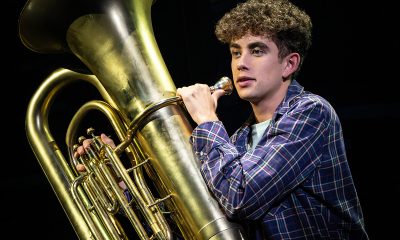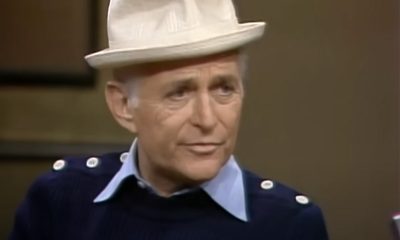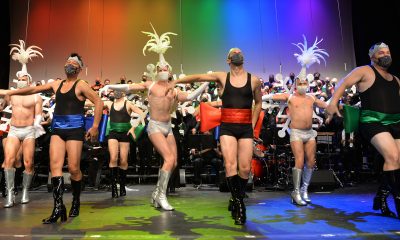Arts & Entertainment
Crewe club
Gay actor plays fey in long-running ‘Jersey Boys’

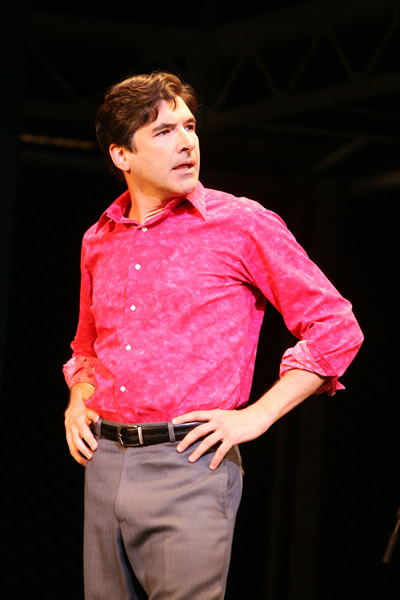
Jonathan Hadley as Bob Crewe in ‘Jersey Boys.’ He says the long-running show has been a blessing. (Photo by Joan Marcus; courtesy Center Stage Marketing)
‘Jersey Boys’
Through Jan. 7
National Theatre
1321 Pennsylvania Avenue, NW
$36.50-$151.50
800-447-7400
nationaltheatre.org
After four years playing in the Tony Award-winning musical “Jersey Boys,” gay actor Jonathan Hadley shows no sign of slowing down.
“My entrance line is, ‘Watch your mouth Toto, you’re not in Newark anymore.’ How great is that?”
Based on audience reaction, it’s pretty great and so is Hadley’s performance as Bob Crewe the flamboyant manager of the legendary Frankie Valli and the Four Seasons. Hadley’s is a showy supporting part in a terrific production that follows the professional and personal fortunes of the group’s members over four decades (approximately1963-2003). A little limp-wristed and plenty camp, the Crewe character is an integral part of the dream machine that catapults four streetwise Italians boys from New Jersey to the stratosphere with songs like “Sherry,” “Walk Like a Man” and “Stay.”
“Today we’d identify Bob Crewe as a gay man,” Hadley says. “He dated women but he had boyfriends. What’s extraordinary to me is that these tough straight guys totally click with this sort of Paul Lynde type. They accept him for who he is — a talented and brilliant producer, manager and lyricist.”
Without Crewe, there would not be the mega-success and long careers. In addition to managing the group, Crewe wrote great lyrics, Hadley says. For instance, late one night while admiring his sleeping boyfriend, he jotted down a little something titled “Can’t Take My Eyes Off You.” The song was a huge hit, arguably one of the biggest pop songs ever and unbeknownst to most, it’s basically a gay love song.
Hadley first played Crewe on Broadway, then in Vegas, and for three-and-a-half years he’s been on the road with the national tour.
“It an adjustment. At times [the cast] feels like carnies. But for me it’s been really interesting not only exploring the country but observing how the show plays in different regions. In the Northeast where there are a lot of Italian Americans, audiences totally get the humor. In the South, they sometimes get upset with the language — we’ve had to modify the script in some places. In the Midwest, they respond to the music. They were wild in Omaha. Wherever we are audiences always leap to their feet to applaud at the end.”
He says the music is a guaranteed pick me up.
“Touring can get tiring, but once you’re onstage and the music starts, you get on that train and ride for two-and-a-half hours. Also, it’s easier to remain engaged with ‘Jersey Boys’ because the book is so good. Every night we tell a story about people living their dreams, seeing them fall apart and putting them back together again.”
Hadley has no plans to give up the role anytime soon. On tour breaks back home in New York City, Hadley sometimes stops by Splash for a drink. Out-of-work actors with an eye on playing Crewe will ask if he’s ready to leave the show. He simply says “Not yet” and buys them a drink.
Growing up in Charlotte, N.C., as part of a theatrical family — more academic (instructors and heads of drama departments) than show biz — Hadley began acting in plays as a child. He did a lot of community theater before studying classically at North Carolina School of the Arts. After graduating, Hadley headed to Broadway and began working right away.
His first job was “Into the Woods,” the famous Stephen Sondheim/James Lapine musical.
“I thought, ‘Hey, I can get used to this, and I’ve been doing the New York thing ever since,” he says.
Although Hadley has never met Crewe in person (they’ve exchanged e-mails), he has studied his voice, photos and quotes.
“Crewe started out as a model in L.A., and despite wanting to become a star, he ended up behind the scenes,” Hadley says. “I’ve heard that he’s very pleased with ‘Jersey Boys’ because he’s finally a star. And I like that I play a part in that.”
a&e features
Your guide to D.C.’s queer New Year’s Eve parties
Ring in 2026 with drag, leather, Champagne, and more
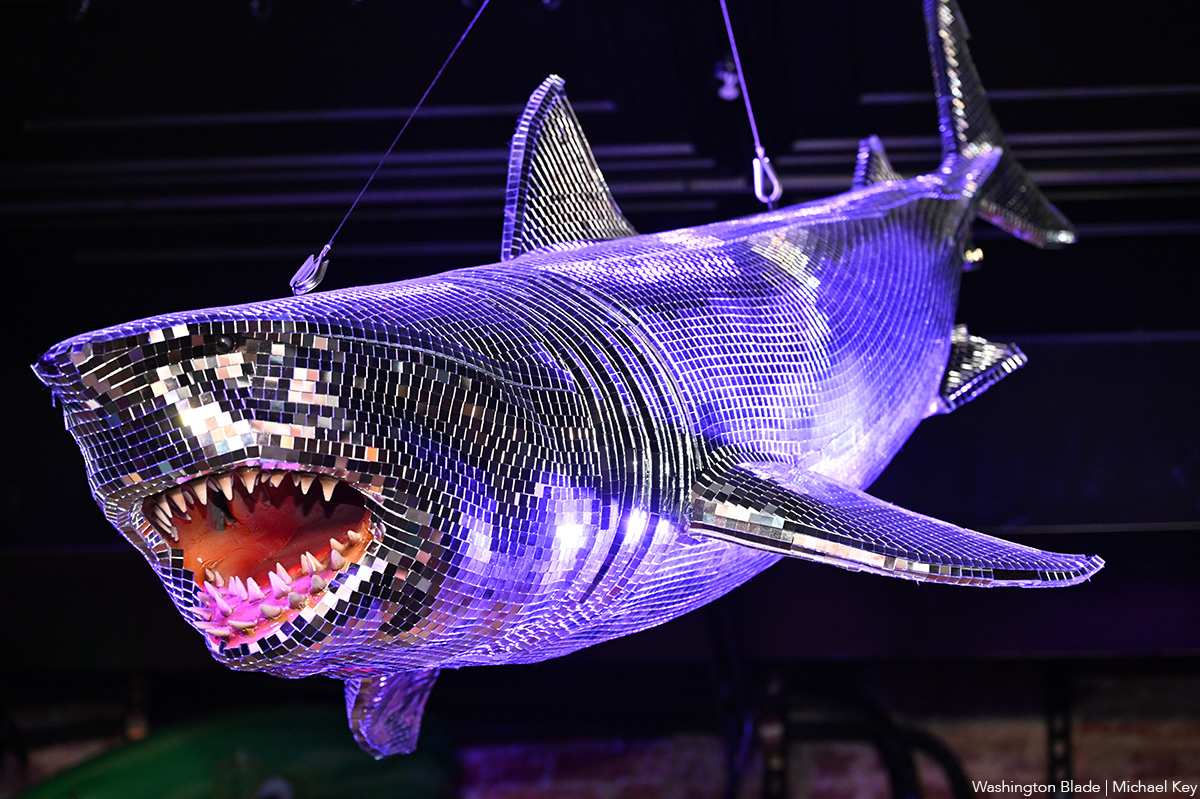
With Christmas in the rear view mirror, we can turn our attention to ringing in a much-anticipated New Year with a slew of local LGBTQ parties. Here’s what’s on tap.
Pitchers
This spacious Adams Morgan bar is hosting the “Pitchers’ Perfect New Year’s Eve.” There will be a midnight Champagne toast, the ball drop on the big screens, and no cover, all night long. The bar doesn’t close until 4 a.m., and the kitchen will be open late (though not until close). All five floors will be open for the party, and party favors are promised.
Trade
D.C.’s hottest bar/club combo is leaning into the Shark motif with its NYE party, “Feeding Frenzy.” The party is a “glitterati-infused Naughty-cal New Year’s Even in the Shark Tank, where the boats are churning and the sharks are circling.” Trade also boasts no cover charge, with doors opening at 5 p.m. and the aforementioned Shark Tank opening at 9 p.m.. Four DJs will be spread across the two spaces; midnight hostess is played by Vagenesis and the two sea sirens sensuously calling are Anathema and Justin Williams.
Number Nine
While Trade will have two DJs as part of one party, Number Nine will host two separate parties, one on each floor. The first floor is classic Number Nine, a more casual-style event with the countdown on TVs and a Champagne midnight toast. There will be no cover and doors open at 5 p.m. Upstairs will be hosted by Capital Sapphics for its second annual NYE gathering. Tickets (about $50) include a midnight Champagne toast, curated drink menu, sapphic DJ set by Rijak, and tarot readings by Yooji.
Crush
Crush will kick off NYE with a free drag bingo at 8 p.m. for the early birds. Post-bingo, there will be a cover for the rest of the evening, featuring two DJs. The cover ($20 limited pre-sale that includes line skip until 11 p.m.; $25 at the door after 9 p.m.) includes one free N/A or Crush, a Champagne toast, and party favors (“the legal kind”). More details on Eventbrite.
Bunker
This subterranean lair is hosting a NYE party entitled “Frosted & Fur: Aspen After Dark New Year’s Eve Celebration.” Arriety from Rupaul Season 15 is set to host, with International DJ Alex Lo. Doors open at 9 p.m. and close at 3 p.m.; there is a midnight Champagne toast. Cover is $25, plus an optional $99 all-you-can-drink package.
District Eagle
This leather-focused bar is hosting “Bulge” for its NYE party. Each District Eagle floor will have its own music and vibe. Doors run from 7 p.m.-3 a.m. and cover is $15. There will be a Champagne toast at midnight, as well as drink specials during the event.
Kiki, Shakiki
Kiki and its new sister bar program Shakiki (in the old Shakers space) will have the same type of party on New Year’s Eve. Both bars open their doors at 5 p.m. and stay open until closing time. Both will offer a Champagne toast at midnight. At Kiki, DJ Vodkatrina will play; at Shakiki, it’ll be DJ Alex Love. Kiki keeps the party going on New Year’s Day, opening at 2 p.m., to celebrate Kiki’s fourth anniversary. There will be a drag show at 6 p.m. and an early 2000s dance party 4-8 p.m.
Spark
This bar and its new menu of alcoholic and twin N/A drinks will host a NYE party with music by DJ Emerald Fox. Given this menu, there will be a complimentary toast at midnight, guests can choose either sparkling wine with or without alcohol. No cover, but Spark is also offering optional wristbands at the door for $35 open bar 11 p.m.-1 a.m. (mid-shelf liquor & all NA drinks).
Movies
Long-awaited ‘Pillion’ surpasses the sexy buzz
A film to admire from a promising new queer director
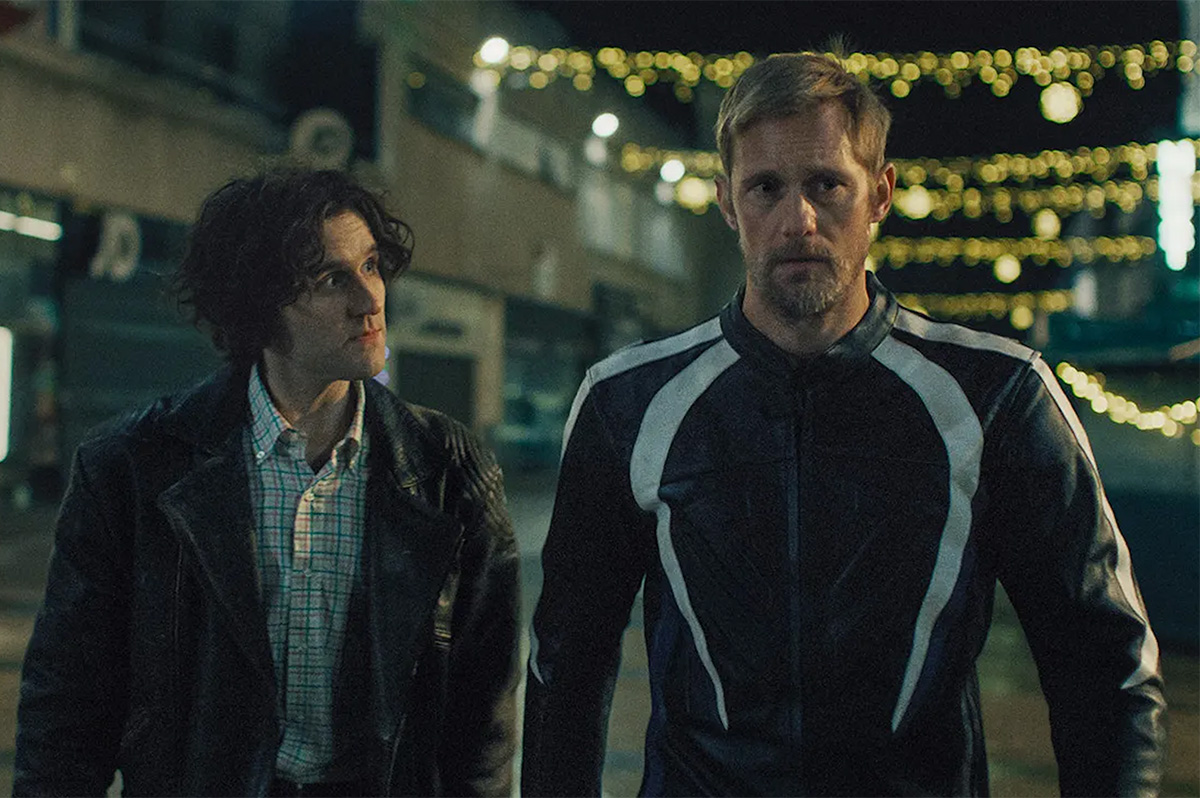
In case you didn’t know, “Pillion” – the title of debut UK filmmaker Harry Lighton’s buzzy gay “fetish rom-com” starring Scandinavian hunk Alexander Skarsgård and “Harry Potter” alumnus Harry Melling – refers to a rear seat on a motorcycle for a passenger, and the person who occupies it is said to be “riding pillion.”
That definition might be useful going into the movie’s story of an introverted gay Londoner who becomes involved with a handsome but icy biker and is introduced to the subculture of Dom/sub relationships, in that it evokes a dynamic that might be said to reflect the one that exists between its two main characters. There is nothing about Lighton’s disarmingly humorous and surprisingly sweet film, however, that seems to imply an interest in offering pat explanations or easy value judgments about the lifestyle it explores, so to think its title is meant as some kind of summation would be a mistake.
It centers on Colin (Melling), a timid parking warden who still lives with his mom and dad (Lesley Sharp and Douglas Hodge) and sings with a barbershop quartet as a hobby. After a gig singing Christmas carols at a gay bar, he catches the eye of sleekly confident Ray (Skarsgård), who gives him his phone number after a brief and thrillingly intimidating interaction. Prompted by his parents, he decides to call, leading to a steamy hookup in a back alley – and eventually, a live-in BDSM situation in which he becomes Ray’s official “sub,” catering to his every need and becoming a member of the gay biker community to which he belongs. It’s all perfectly fine with Colin, who embraces his role with pleasure; but when he begins to long for a deeper connection with the enigmatic and emotionally distant Ray, it triggers a disruption in the dynamic of their relationship, putting it to a test it may not be able to pass.
“Pillion” was already creating a stir before its prize-winning debut at the Cannes Film Festival last May, largely thanks to the highly publicized casting of Skarsgård as the leather-clad leading man in a gay BDSM romance. But near-universal critical acclaim quickly validated the buzz, turning it into one of 2025’s most anticipated movie releases – particularly, of course, for gay audiences, and especially for those who are part of the BDSM community and rarely get the opportunity to be “seen” on the screen as anything other than a lazy stereotype.
Naturally, much of that buzz has been driven by a prurient fervor, fueled by the promise of kinky onscreen sex and rumors of a notorious close-up highlighting the full-frontal assets of a certain Swedish movie star. One of the things that’s remarkable about “Pillion,” however, is that while it certainly doesn’t downplay the overt sexual aspect of the relationship at its center, it doesn’t use them to titillate or shock us. Its plentiful scenes of intimacy are sexy, yes, but they also chart the development of the characters’ bond together, expressing feelings that can only be left unspoken within their agreed-on dynamic. They advance both the story and our awareness of the characters’ psychology, and while they may occasionally provide a jolt for viewers not accustomed to seeing gay fetish sex portrayed explicitly on screen, they successfully capture the joy of the experience instead of making it feel sensationalized or lurid.
In fact, once “Pillion” ends, it’s not the sex (not exclusively, at least) that lingers in our mind; it’s the delicate balance it maintains between tension and ease, detachment and tenderness, rigidity and flow – mirroring the surging passions contained within the strictly regimented order of their power dynamic. It’s the depth of Melling’s film-anchoring performance, in which he undergoes an entire voyage of discovery that emphasizes Colin’s strength, not his timidity, and allows us to relate to him in ways that may surprise us. It’s the authenticity of the relationships between all the characters, from Sharp and Hodge’s doting parents to Scissor Sisters front man Jake Shears (in his film acting debut) as a fellow sub who ignites a spark of jealousy between Colin and Ray; most of all, it’s the way that it allows the story to move, with a slow and methodical rhythm – reflected in the measured strains of Eric Satie’s “Gymnopode No.1” that echo through Oliver Coates’ evocative score – that makes it all feel perfectly natural.
And yes, it’s also the presence of Skarsgård, who subtly (and with wry humor) contrasts tight-lipped alpha stoicism with his flawless male beauty that feels like a force of nature. We don’t know much about Ray, ever, through the dialogue in Lighton’s tersely worded screenplay, but we can draw our own conclusions from the eloquent silence that Skarsgård wraps around the character like a security blanket. Best of all, he never uses his “Dom” role in the film to overshadow Melling – it’s Colin’s story, after all, and Skarsgård’s Ray deploys a tactic of “quiet command” on him throughout without ever stealing his spotlight.
As for the film’s writer/director, Lighton manages perhaps the most delicate balancing act of all. He takes a story (adapted from a novel by Adam Mars-Jones) about someone discovering himself in the BDSM community, who engages in sexual behavior that’s likely out of the comfort zone of many viewers and enters a “romantic” partnership most people would find unacceptable, and turns it into a movie that is all about the complexities of human experience. You may not know much (or want to) about life as a sub in a BDSM partnership, but you know what it feels like to love someone, and to long for love in return; Lighton understands that “Pillion” is a story about that, and he knows how to tell it so that you will understand it, too.
That said, it’s obvious there will be many audiences out there for whom a movie about leather-clad queer fetish sex might simply be a step too far for them to take. Anyone approaching “Pillion” should be aware that, depending on your own level of familiarity – or comfort – with the BDSM lifestyle, your reaction may vary across a spectrum of perspectives; if you’ve been around it, nothing the movie shows you is likely to ruffle your feathers, and if you haven’t, well, only you know your limits.
For us, it’s a film to admire from a promising new queer director, shining a light on an insular culture within the larger rainbow community with intelligence, dignity, and a refreshing lack of the homophobic tropes that so often haunt queer movies, even when they are made by queer filmmakers themselves.
Unfortunately for Americans, while “Pillion” was released in the UK on Nov. 28, we won’t get a chance to see it until Feb. 6. With the buzz now even stronger and the stars in full “promotional” mode on the talk show circuit, we thought it would be a good idea to let you know that the wait might still be a while, but it will be worth it.
After all, as any good Dom can tell you, a pleasure withheld tastes even sweeter when it’s finally given.
Books
‘Dogs of Venice’ looks at love lost and rediscovered
A solo holiday trip to Italy takes unexpected turn

‘The Dogs of Venice’
By Steven Crowley
c.2025, G.P. Putnam & Sons
$20/65 pages
One person.
Two, 12, 20, you can still feel alone in a crowded room if it’s a place you don’t want to be. People say, though, that that’s no way to do the holidays; you’re supposed to Make Merry, even when your heart’s not in it. You’re supposed to feel happy, no matter what – even when, as in “The Dogs of Venice” by Steven Rowley, the Christmas tinsel seems tarnished.

Right up until the plane door closed, Paul held hope that Darren would decide to come on the vacation they’d planned for and saved for, for months.
Alas, Darren was a no-show, which was not really a surprise. Three weeks before the departure, he’d announced that their marriage wasn’t working for him anymore, and that he wanted a divorce. Paul had said he was going on the vacation anyhow. Why waste a perfectly good flight, or an already-booked B&B? He was going to Venice.
Darren just rolled his eyes.
Was that a metaphor for their entire marriage? Darren had always accused Paul of wanting too much. He indicated now that he felt stifled. Still, Darren’s unhappiness hit Paul broadside and so there was Paul, alone in a romantic Italian city, fighting with an espresso machine in a loft owned by someone who looked like a frozen-food spokeswoman.
He couldn’t speak or understand Italian very well. He didn’t know his way around, and he got lost often. But he felt anchored by a dog.
The dog – he liked to call it his dog – was a random stray, like so many others wandering around Venice unleashed, but this dog’s confidence and insouciant manner inspired Paul. If a dog could be like that, well, why couldn’t he?
He knew he wasn’t unlovable but solo holidays stunk and he hated his situation. Maybe the dog had a lesson to teach him: could you live a wonderful life without someone to watch out for, pet, and care for you?
Pick up “The Dogs of Venice,” and you might think to yourself that it won’t take long to read. At under 100 pages, you’d be right – which just gives you time to turn around and read it again. Because you’ll want to.
In the same way that you poke your tongue at a sore tooth, author Steven Rowley makes you want to remember what it’s like to be the victim of a dead romance. You can do it here safely because you simply know that Paul is too nice for it to last too long. No spoilers, though, except to say that this novel is about love – gone, resurrected, misdirected – and it unfolds in exactly the way you hope it will. All in a neat evening’s worth of reading. Perfect.
One thing to note: the Christmas setting is incidental and could just as well be any season, which means that this book is timely, no matter when you want it. So grab “The Dogs of Venice,” enjoy it twice with your book group, with your love, or read it alone.
The Blade may receive commissions from qualifying purchases made via this post.

